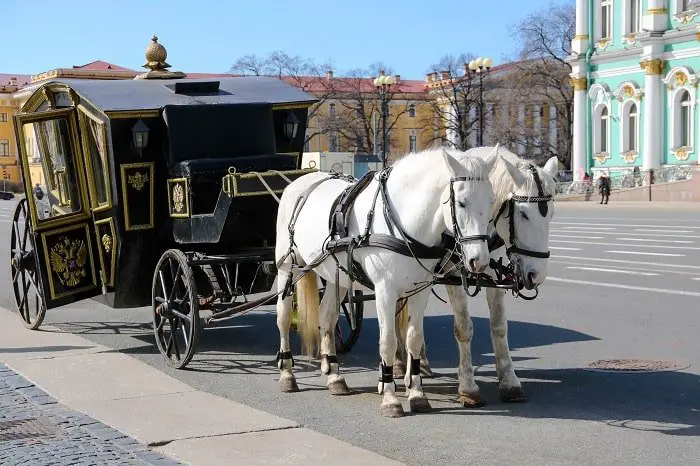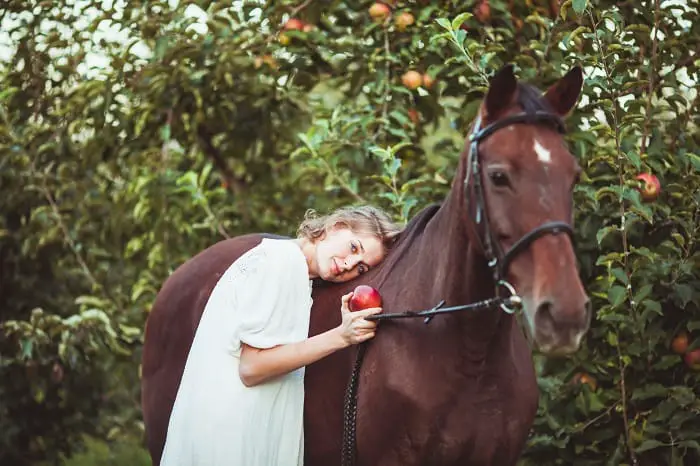Last Updated on September 28, 2020
Horses and humans have had a relationship unlike any other. There have been many uses of horses throughout history such as in wars, work, as transportation and as companions. Without horses, our world would not be the same as it is today.
Uses of Horses Throughout History: Horse Domestication
Horses were first domesticated around 3500 BC. It is believed that man first tamed horses in the steppes of Russia and Kazakhstan. They were introduced to the Near East around 2000 BC where they were ridden as well as used to pull wheeled vehicles such as chariots and carts.
Once the horse became domesticated, it changed the dynamic of the world. People were able to travel further distances and carry more supplies due to the strength and endurance of horses. Wars also changed, as soldiers were able to drive chariots and ride horses into battle, making them a force to be reckoned with.
Horses have also been used for work since ancient times. They have been used to plow fields, as their strength and efficiency was far more effective than manpower. Horses were also used in trade routes, helping spread goods from all over.
Uses of Horses Throughout History: War
The history of war would likely be very different if horses were not used. Since ancient times, people have used horses in war. Horses provided power and speed that man had not known before.
Early War Horses
For nearly a millennium, warhorses were primarily used to pull only chariots into battle. As time went on, horses were ridden into battle, leading charges of soldiers. Horses also pulled wagons full of supplies.
Uses of Horses Throughout History: Middle Ages
During the middle ages, horses would carry knights into battle. These horses often wore armor to protect themselves from battle wounds.
Knights would ride destriers in battle, carrying their lance and sword while wearing their armor. Destriers were highly trained warhorses that were worth top dollar. They were always stallions and their natural aggression was stimulated to become fierce fighters.
Chargers were more commonly used in wars, as they were more accessible and affordable. Chargers were war horses with less prestige than destrier, however, they still had war training. Chargers were also stallions.
In some cases during the middle ages, horses were only used to transport soldiers and soldiers would fight battles on foot. Some soldiers would have to travel hundreds of miles to reach the war. In 1511, Henry II traveled over 400 miles besieging the French countryside on his way to battle with his army in six weeks, a feat that would not have been possible without horses.
Uses of Horses Throughout History: Napoleonic Wars
Though Napoleon did not grow up around horses, he knew the importance of having a cavalry. His cavalry was well trained which lead to many major victories for his army. Napoleon’s beloved Arabian stallion, Marengo, carried him into many battles.
The French used horses to lead charges into battle and pull heavy artillery. The cavalry was very effective against marching infantry. If a battalion was formed, they could be easily broken up by a well-formed cavalry charge.
Unlike other European leaders that commonly used Thoroughbreds for their cavalries, Napoleon primarily used Arabians and Barbs. He preferred their small stature, as they were easier to mount. Napoleon’s brave cavalry lead him to several victories.
The American Civil War
Horses played a large part in the civil war. They were used to transport troops, supplies, medicine, and weapons. Generals were rarely seen walking by foot, as they often rode their trusty horses to check up on their troops.
Members of the cavalry in the Confederate army had to supply their own horses. Many of the soldiers took horses from farms, as there was often a shortage of well-trained horses that could withstand the demands of war.
The Union army was known for its strong cavalry. They purchased many Morgan horses, due to their endurance, easy-keeping, bravery, and willingness to please.
Following the Battle of Gettysburg, the Union cavalry fought fifteen battles in sixteen days, overpowering the Confederate cavalry and capturing around 4,000 horses. The strong presence of the Union cavalry helped eventually lead to a Northern victory.
World War I & II
Even with the invention of planes, cars, and tanks, horses were still used in both WWI and WWII. Many times, throughout the wars, horses were vital for transportation, in addition to being used in the cavalry.
During WWI, cavalries were still commonly used as powerful regiments. Horses were also used to transport equipment, as tanks and trucks often broke down because they were new inventions. Horses often helped boost morale of soldiers in difficulties of the disease-stricken conditions of the war.
Even with the continued advancement of modern technology by WWII, horses were still regularly used in cavalries and transportation. In the German army, 80% of their transportation was made up of horses. Horses provided reliable transportation and were able to go to places that were difficult for vehicles to reach.
Horses for Transportation
Ever since the domestication of horses, they have been used as a means of transportation. They have been ridden, pulled carriages and wagons. Horses allowed the man to go places they had never been before and travel at a much faster pace.
Horses allowed humans to move around much easier. They also allowed for a quicker communication, as messages could be relayed at a much faster pace. They allowed for easier trading, which meant goods could be dispersed all throughout the world.
Horses have allowed humans to move over vast areas, which would have been difficult to do by feet. People were able to move hundreds of miles away, taking their families and belongings with. From allowing for quicker and more efficient trade routes to pulling wagons full of pioneers across the American countryside to pulling people in carriages from town to town, horses were once the backbone of transportation.
Horses for Work
Horses have also helped humans with their jobs. They have allowed people to get more work done at an efficient pace, thanks to their strength and endurance.
Horses have plowed fields and played vital roles in getting farm work done. They have worked down in mines, bringing down supplies and taking back mined goods. They have pulled fire trucks, milk trucks and been used as police horses.
Horses are also used for therapy work. They have been ridden for therapy by disabled people to help improve their physical and mental health. Miniature horses have also been popular choices for emotional support animals and as seeing-eye guides.
Horses as Companions
One of the most important roles horses have played in history is that of being a companion. For thousands of years, people and horses have shared a strong bond. We have admired them, breed them, raced them, showed them and loved them.
For thousands of years, people have kept horses as prized possessions. People have been racing horses for centuries and breeding the finest stock. People have also shown horses for hundreds of years, paying top dollar for champions.
Horses in History
Horses have played a huge role in history. They have changed how wars are fought, provided us fast and efficient transportation, helped us work and most importantly been loving companions. There is no bond like the one between man and horse.
Please comment if you enjoyed this article or have any remarks regarding this post!
Michael Dehaan is a passionate horse owner, horse rider, and lover of all things equine. He has been around horses since he was a child, and has grown to become an expert in the field. He has owned and ridden a variety of horses of different breeds, and has trained many to compete in shows and competitions. He is an experienced horseman, having worked with and competed many horses, including his own. He is an active member of the equestrian community, participating in events and teaching riding lessons.


